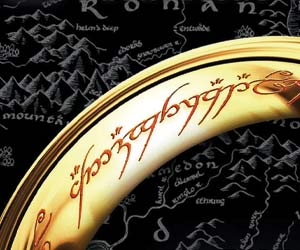The Silmarillion
Select Format
Select Condition 
Book Overview
For the first time ever, a very special edition of the forerunner to The Lord of the Rings, illustrated throughout in color by J.R.R. Tolkien himself and with the complete text printed in two colors.... This description may be from another edition of this product.
Format:Paperback
Language:English
ISBN:0618126988
ISBN13:9780618126989
Release Date:April 2001
Publisher:Houghton Mifflin
Length:384 Pages
Weight:1.15 lbs.
Dimensions:0.9" x 5.5" x 8.3"
Customer Reviews
5 ratings
Tolkien's masterwork suffers slightly from his son's heavy-handed editing
Published by Dale Page , 7 months ago
JRR Tolkien set out to write a fully-formed mythology for the British Isles. This book, which has its origins before the more famous Lord of the Rings trilogy, was piecemealed together from tales which existed in several form or were close to finished when Mr. Tolkien passed away.
His son and literary executor, Christopher, cobbled these together, claiming to have edited only as necessary. The fact that several of tales contained within have been published in different forms by JRR's estate makes one question how light a hand (spoiler, it probably wasn't) Christopher used.
That said, it is a must read for those of us who are nerds at heart for Middle Earth. If you're a casual Tolkien reader, you'll probably find it tough to slog through.
Great book itself, but the condition...
Published by Nicole Gershfeld , 7 months ago
The book itself is great, although a bit hard to read, and if you found LOTR hard to read, this book is not for you. I ordered it in very good condition, and it arrived in terrible condition, with a different cover, super small, and dirty pages yellow with age and maybe mold. Don't purchase this book from here.
Tolkien's true life work, ultimately unfinished though it is
Published by Thriftbooks.com User , 16 years ago
In the Tolkien canon, THE SILMARILLION is the most highly contested of all his works. Constructed as a prehistoric history of the Universe, the book has the cultural significance of the Bible in Tolkien's universe. It is Tolkien's primary work, but it's also his most troublesome, in more ways than one. One thing you need to know. In Tolkien scholarship, there are two primary ways to refer to the "Silmarillion". One is the Silmarillion, the legendarium proper, and then the 1977 SILMARILLION, which may or may not be what Tolkien envisioned. THE SILMARILLION, the book Tolkien spent all of his adult life writing, was, sadly, incomplete when Tolkien died at the age of eighty one in 1973. Naturally, this begs the question why did it take him decades to write the book, and it still be unfinished after all that time? Well, to understand that, you need to understand two things: the scope of the project, and how Tolkien worked. The scope of the book was a complete imaginary history, a totally self-contained mythology, all written and developed for his home country, England (my home country as well). Imagine the Greek and Roman mythologies, all those myths and gods, developed by one man. Imagine Homer completely inventing all the gods for his stories. Imagine how hard that would be to come up with your own mythological traditions as such. No wonder Tolkien had such a hard time completing the work. Now, the scope (which is extremely ambitious for any artist) was compounded by how Tolkien worked. First, he was a philologist first and foremost, and so before the stories he invented languages. All of these languages (which would have taken a life-time to develop on their own) had their own history, and are so interlocked with the mythology that you cannot remove them. He developed the main body of legends around these languages. Many features of the central body of legends changed relatively little over the years, but he wrote different versions of them at different times and in different styles. Some of the legends were set in poetry, those in annalistic histories, others in condensed summaries, and others in the more traditional (at least, for modern readers) novel format. A lot of these writings are also unfinished, due to Tolkien's perfectionist tendencies. Christopher Tolkien said that for most of his father's writing there existed a stable tradition from which Tolkien worked from, but there was no such thing as a stable text for the primary legends. All this is tied to how Tolkien worked. C. S. Lewis famously stated that you did not influence Tolkien, you may as well as try to influence a bandersnatch. Tolkien would either take no notice of your criticism, or else he would start all over from the beginning. And so he did. A lot. Tolkien would reach a certain portion of the draft, be unsatisfied, and began the whole thing over again, while never reaching the end. Or Tolkien would have two copies of the same manuscript, one to be
awesome
Published by Thriftbooks.com User , 25 years ago
The story of "The lord of the Rings" is spectacular,because it took me to a whole other world where I felt I was in the adventure myself.I believe this is one of the best books I have ever read.
Both Tolkien and Martin Shaw shine in this audio edition
Published by Thriftbooks.com User , 25 years ago
A long-time Tolkien fan, I have always enjoyed The Silmarillion, though it's never been my favourite. Martin Shaw's reading may just change that! Hearing Mr Shaw's rendering of Tolkien's prose is a truly magical experience. I enjoyed his reading of The Hobbit, but this text is much more moving. Mr Shaw manages both the high linguistic style and the Elvish words with dignity and makes the text come alive in a way that is simply amazing. (We can only hope that Mr Shaw has plans for The Lord of the Rings.) The decision of the publisher to release the text unabridged is also very welcome -- the mythic style and scope of the book demand that every story in it be told, and it is well worth the cumulative price of the volumes.
The Silmarillion Mentions in Our Blog

A Lord of the Rings Review: 10 Obscure Facts That Only Diehard Fans Would Know
Published by Ashly Moore Sheldon • August 11, 2022
We've been nerding out about Amazon's upcoming Lord of the Rings series premiering on September 22. So, we're reading everything we can about the history of these epic stories and we've learned some pretty interesting things. Here are ten little-known facts we've uncovered.

Are You Afraid of Big Bad Books?
Published by Bianca Smith • March 26, 2018
Big books have fabulous stories, but are intimidating to start. Here are some tips to help you read big books.






